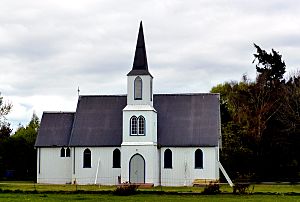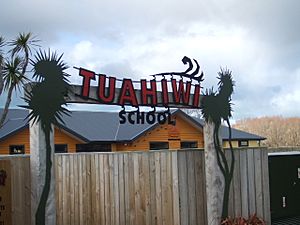Tuahiwi facts for kids
Quick facts for kids
Tuahiwi
|
|
|---|---|
|
Village
|
|

St Stephen’s Anglican Church
|
|
| Country | New Zealand |
| Region | Canterbury |
| District | Waimakariri District |
| Ward |
|
| Community |
|
| Electorates |
|
| Area | |
| • Total | 22.71 km2 (8.77 sq mi) |
| Population
(June 2023)
|
|
| • Total | 1,010 |
| • Density | 44.47/km2 (115.2/sq mi) |
| Time zone | UTC+12 (NZST) |
| • Summer (DST) | UTC+13 (NZDT) |
Tuahiwi is a small village in New Zealand. It is located between the towns of Woodend and Rangiora. You can find it about 6 kilometers north of Kaiapoi.
Contents
Exploring Tuahiwi's Past
Early History
The area where Tuahiwi now stands was once home to a special fortified village. This village was called a pā by the Ngāi Tūahuriri hapū, a group of the Ngāi Tahu Māori people.
In 1831, before European settlers arrived, the pā was attacked by Te Rauparaha. This attack was a revenge raid, known as utu. However, the Ngāi Tūahuriri people got their land back when the attackers left.
In 1848, a man named Walter Mantell set aside this land for Māori. This happened after an important agreement called Kemp's Deed was signed.
Growing Over Time
By 1870, there was a meeting house in Tuahiwi. This building almost burned down!
Important things started to happen in Tuahiwi. A Māori mission was set up. This included a church built in 1867. The foundation stone for the church was laid by Governor George Grey when he visited.
By 1890, Tuahiwi was a neat village. The old Māori homes were replaced by stronger cottages with fences and gardens. A school, the church (St Stephens), and a meeting hall were in the center. There was even a flagpole in front of the meeting hall. The Native Land Court sometimes used the hall.
Key Events
In 1900, the Tuahiwi hall was used by a volunteer army group. This group included Māori soldiers from Tuahiwi. They wanted to fight in the Second Boer War but were not allowed. They protested to the Premier, Richard Seddon, in 1901.
In December 1901, Reginald Koettlitz and members of Scott's Discovery Expedition visited Tuahiwi. They came before their trip to Antarctica from Lyttelton.
A special school for Māori girls, Te Wai Pounamu College, started here in 1909. It later moved to Christchurch.
People and Population
The Tuahiwi area covers about 22.71 square kilometers. It has an estimated population of 1,010 people. This means there are about 44 people living in each square kilometer.
In 2018, Tuahiwi had 945 residents. There were 318 households, with slightly more males than females. The average age was 44.2 years. About 16.5% of the people were under 15 years old.
Most people in Tuahiwi are of European/Pākehā background (85.7%). About 23.2% are Māori. Some people identify with more than one ethnicity. About 14% of the people were born outside New Zealand.
When asked about religion, 58.7% said they had no religion. About 29.2% were Christian.
Education
Tuahiwi School is a primary school for students in years 1 to 8. It has 149 students. The school offers a special choice: students can learn in either the Māori language or English. This makes it a bilingual school.
Notable People from Tuahiwi
- Aroha Reriti-Crofts - A well-known community worker.
- Erihana Ryan - A Māori psychiatrist.
- Wiremu Nahira Te-hoika - A Māori chief born around 1812 in Kaiapoi. He moved to Tuahiwi in 1850 and passed away there in 1903.


